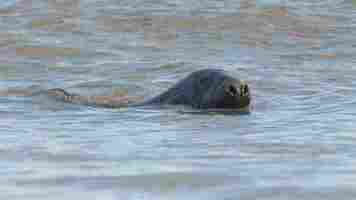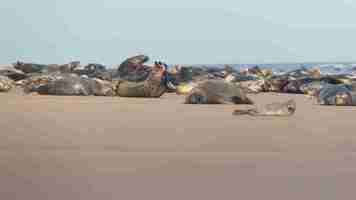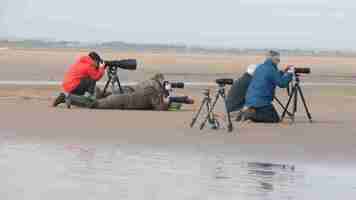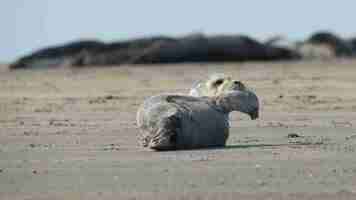Nikon School review - Join the pros
Buying a posh camera and knowing how to get the best out of it are two completely unrelated things. Nikon has been working hard on addressing the latter, launching its photography school courses to help people get more out of their camera and improve the quality of their shots.
We were impressed with the Getting started with DSLR photography course , which is designed to get people away from the camera's automatic settings and learn how the manual controls worked. Once you're armed with those kinds of skills, putting them into practice requires a different sort of training, which is where the 'Join the pros' range of courses comes in.
These are designed to get you time with a professional photographer, out in the field, learning how to put your skills and knowledge together to capture better shots. For this review we headed out to RAF Donna Nook in Lincolnshire to shoot its colony of grey seals (there are common seals, too). Our trainer for the day was Wildlife Photographer of the Year-winner, Chris Gomersall .

Getting started
One of the main reasons to do this kind of course, rather than heading off by yourself, is all about fieldcraft and respect for the environment you're entering. Although any members of the public are free to walk across the beach to view the seals, there's a real danger of scaring them, causing them to panic and head for the water. With a good chance of pregnant animals or seal pups, this kind of action should be avoided.
In the case of our trip, Nikon and Gomersall consulted with the Lincolnshire Wildlife Trust before hand, so that it was clear what we were doing and how the trip would be approached. Once we arrived at the location at 6am, decked out in the waterproof trousers, coats and wellington boots (you have to wade through shallow water to reach the seals), the first lesson was that it was going to take time to get close to the seals and that we had to do it both carefully and slowly, with the entire group ordered to stop if the seals looked like they were getting agitated. Over the period of the day, Gomersall showed us how to move and crawl slowly towards the seals, getting closer without disturbing them.
Blundering out by ourselves without a professional would have meant worse shots and, far more importantly, damage to the wildlife. With a professional to rely on, both of these threats are negated.

Kit
One of the benefits of doing this type of course is that Nikon provides some kit for people to use during the day. On this course it was a 600m f/4 lens, which costs around £7,000 brand-new. While you're told to bring your own zoom lenses (a minimum of 300mm is recommended), being able to get your hands on high-end, professional kit is something else.
On top of that, the course recommends bringing other kit. Tripods can be useful, but you have to remember that you need to move with them while crouching down. A beanbag makes a lot of sense in this kind of situation. One course member had a mini tripod around 30cm tall, mounted on a round disc, so that he could use it while lying down and easily slide it across the sand. It's easy to tell the professionals from the amateur's, though, as they tend to go for the lighter and cheaper solution: Gomersall had a beanbag resting on a Frisbee to do the same thing.

Hands-on shooting
While the London-based courses are more prescriptive and follow a set script, to take you through the controls you need, the pro courses are much more free-flow. It's assumed, as the course notes state, that everyone on it is familiar with their camera's controls and, if new to photography, has completed the beginners' guide.
Given that the environment can't be controlled, and getting the perfect shots is about flexibility, this looser approach works much better. Gomersall was really there as a guide, giving tips, answering questions and pointing out good shots and what to look out for. It shouldn't be underestimated how important and useful getting tips from a professional can be. For example, we'd got our camera set up in the standard focussing mode: pressing halfway down on the shutter engaged the autofocus. Gomersall told everybody that back button focus was the way to go.
For those that aren't aware, back button focus moves the control onto the back of the camera (typically the AE/AF lock button). Pressing this button engages the auto-focus, so that the shutter button is purely to measure exposure (depending on the mode) and take the shot.
The benefit of this technique is that you can set the camera to AF-C (continuous autofocus). When you want to compose a portrait or take photos of objects that aren't moving much, you can hit the focus button to compose your shot, and then rattle off as many pictures are you like. As each shot doesn't require the camera to re-focus, you can capture multiple frames quickly.

Should something suddenly happen, such as burst of action from your subject or a bird quickly taking off, you can hit the focus button, track your subject and grab the shots you need. It made a big difference to our photography and made composing shots easier.
Similarly, Gomersall explained his usual camera settings. You're free to set you camera up as you see fit, as there's no right or wrong settings, but getting the insight into why a pro shoots in a certain way, certainly makes you think more about your own camera settings. After that, the day is a lot about manoeuvring into the right position to capture a range of different shots, with Gomersall on-hand to suggest shots and apertures to capture different aspects of the seals.
Later stages
Once Gomersall was happy that everybody knew what they were doing, and the seals were used to our presence, the opportunity was there to spread out by ourselves and get the shots we wanted, all while observing the practicalities we'd be told before. This part of the day was great, as you can get more personal shots and something a bit different to everyone else. We had a male seal move his way down the beach, crawl passed us a few metres away and splash into the sea - an incredible experience.
We also had chance to view the sandpipers close up, as they wandered the shoreline feeding in the tide. Rather incredible birds, if you stand still, they get used to you and will wander around you.
Conclusion
The Pro courses vary in price, depending on where they are and how long they're for, but the seals course was a reasonable £129. Our day started at 6am and was scheduled to last until 4pm, although by around 2:30pm the class was tired and we were satisfied that we'd caught all the action that we needed.
As we said at the start of this article, the day is about so much more than plain photography, making it a true wildlife experience. With a professional on hand to answer questions, dish out tips and show you how to get close to the wildlife, it made the course worth every penny. We recommend this kind of experience to any keen wildlife photographer looking to get started.